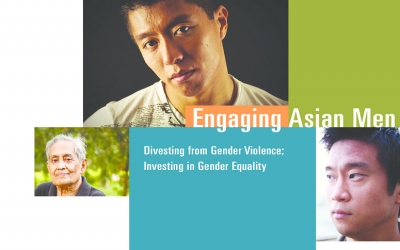Engaging Men
In their introduction to a multi-country study on men and gender violence in Asia and the Pacific, the authors write: The elimination of harmful gender norms and practices can be achieved through the engagement of men and boys. (…) Ending violence against women requires coherent policies and programmes that emphasize gender equality as non-negotiable and the transformation of social norms.
The notion of ‘engaging men and boys’ has come to mean a lot of things, from men’s role in the anti-domestic violence movement to approaches that range from bystander engagement to tertiary prevention. Because sociocultural differences influence how patriarchy is enforced, how hetero-normative masculinity is defined, and how women’s self-determination is expressed or controlled, these very contexts also influence what engaging men means.
Engaging men starts with confronting perpetration: What are men in Asia & the Pacific reporting about their use of violence against women?
A study of 10,000 men and 3,000 women in Bangladesh, Cambodia, China, Indonesia, Papua New Guinea, and Sri Lanka confirm Asian and Pacific Islander women’s experiences of victimization. Findings show the following rates of:
Lifetime physical and sexual partner abuse
- 26% – 80% of ever-partnered men reported perpetrating physical and/or sexual partner violence
- 25% – 68% of ever-partnered women reported experiencing physical and/or sexual partner violence in their lifetime
- Lifetime physical partner violence perpetration was more common than lifetime sexual partner violence perpetration; except in Cambodia and Indonesia where the reverse was true
Rape against women and girls
- 10-62% of men reported that they had perpetrated rape against a woman or girl in their lifetime.
- Half of all men who perpetrated rape did so for the first time when they were teenagers (younger than 20 years).
- Rape of an intimate partner was more common than non-partner rape
- The most commonly reported motivation for rape was men’s sense of sexual entitlement.
Resources on Engaging Men
Engaging Asian Men: Divesting from Gender Violence; Investing in Gender Equality, 2013
What will it take for men in our Asian communities to divest from gender violence and invest in gender equality?
Other Resources
Manavi: Engaging Men to End Domestic Violence in South Asian Communities in the United States (2015)
Men Can Stop Rape: Engages young men in preventing gender violence
Men Care: A global fatherhood campaign for equitable, nonviolent fathers and caregivers
Men Stopping Violence: Organizes men to end male violence against women and girls
Futures Without Violence: Publications and technical assistance on engaging men, including the Coaching Boys into Men and the Y Factor programs
